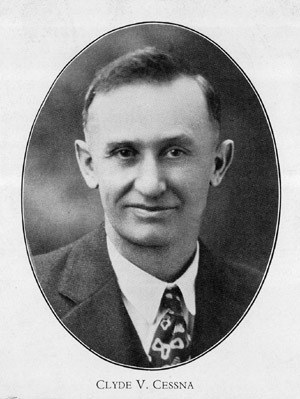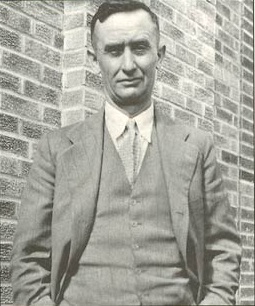<Back to Index>
- Aircraft Designer Clyde Vernon Cessna, 1879
- Composer Vítězslav Novák, 1870
- Vice Premier of the People's Republic of China General Lin Biao (Lin Yurong), 1907
PAGE SPONSOR


Clyde Vernon Cessna (5 December 1879 - 20 November 1954) was an American aircraft designer, aviator, and founder of the Cessna Aircraft Corporation.
Clyde Vernon Cessna was born in Hawthorne, Iowa, on December 5, 1879. When he was 2, he and his family moved to rural Rago in Kingman County, Kansas, along the Chikaskia River. During his boyhood he used his self - taught innovation and mechanical skills to improve farm machinery and to develop new farming methods. He later became a successful car dealer in Enid, Oklahoma.
Clyde's interest in aviation began in 1910 after witnessing an aerial exhibition in his home state of Kansas. It was this exhibition that led him in future years to pursue his career in aviation. After realizing his interest in aviation, Clyde left Oklahoma and moved to New York where he worked for a short period at the Queen Aeroplane Company where he first learned about the construction of aircraft.
In 1911, he set out to build his first airplane, an airplane he named "silverwing". His first design was a monoplane, constructed of spruce and linen and which took the form of an American version of the Bleriot XI.
The engine was a modified Elbridge motorboat motor, dubbed the "aero
special", which was a 2 stroke, 4 cylinder engine with a maximum of
40 hp (30 kW) and 1,050 rpm. Upon completion, he sought to test the aircraft at the Great Salt Plains (adjacent to the Salt Plains National Wildlife Refuge) in Alfalfa County, Oklahoma. His first attempt at flight ended in a ground loop which
required $100 to repair. After repairs, Cessna attempted flight 13 more
times, each time ending in some sort of failure. Finally on his 13th
attempt, Cessna got a glimpse of hope as his aircraft bounced up into
the air for a short time before crashing into the trees as he attempted
to turn it. After his crash, Cessna exclaimed in frustration, "I'm
going to fly this thing, then I'm going to set it afire and never have
another thing to do with aeroplanes!". Finally, in June 1911 Cessna had
his first successful flight. The crowds that had scoffed at his
failures changed their tone and began calling him a "daring hero" and
nicknamed him the "Birdman of Enid". Cessna
continued to teach himself how to fly over the next several months
until December 1911 when he made a successful 5-mile (8.0 km)
flight and a successful landing at the point of departure.
It was in 1916 that Clyde acquired a vacant building to begin building a new aircraft for the 1917 aviation exhibition season. His factory served a dual purpose as he also opened a flight school in which he had five enrolled student pilots. However in April 1917 when the United States declared war, the exhibition flying market ground to a halt. With his primary source of income grounded, Clyde returned to his old home near Rago, Kansas, where he resumed his duties on the family farm.
In the years following World War I public interest in private flying increased, leading Cessna in 1925, along with Walter Beech and Lloyd Stearman, to found the Travel Air Manufacturing Company which was located in Wichita, Kansas. While Cessna was president, the company soon became one of the leading United States aircraft manufacturers. This success may be attributed to Cessna's advanced design concepts and aircraft that attained international recognition in the course of establishing numerous speed and distance records. However, after two years at the company, design disputes with his partners over the monoplane versus the biplane, Cessna left the company with plans to again start his own.
On 7 September 1927, the Cessna Aircraft Corporation officially became incorporated. In the later part of 1927, Cessna struggled to design and build an efficient monoplane. The "AW" was completed near the end of 1927, a single wing aircraft with top speeds of up to 145 mph (233 km/h) and a maximum cruise time upwards of 7 hours. The first plane flew on August 13, 1927. In the following decade, the company produced many racing and sports aircraft generally known for their tradition of safety, performance and economy.
Despite the success of new models, the Great Depression led to a catastrophic drop in aircraft sales, a bankruptcy filing for the corporation, and the complete closure of the company in 1931. In 1934, Cessna reopened his Wichita plant which he soon sold to his nephews in (1936).
After selling the Cessna Aircraft Corporation to his nephews, Cessna returned to a life of farming. Upon
his nephews' request, Clyde agreed to participate in the company but
served mostly in a ceremonial capacity and stayed out of the company's
day to day business. Clyde Vernon Cessna died in 1954, at the age of 74.
